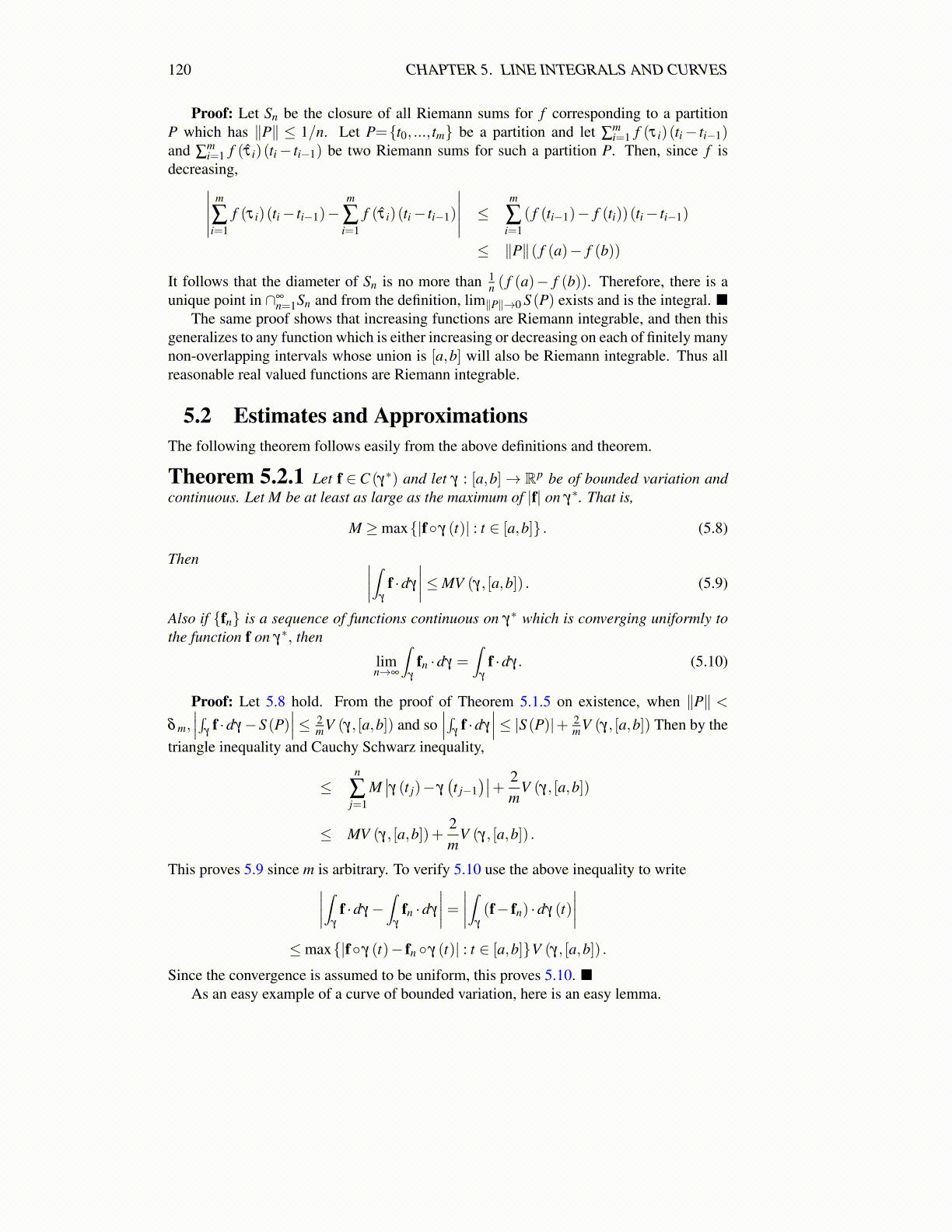
120 CHAPTER 5. LINE INTEGRALS AND CURVES
Proof: Let Sn be the closure of all Riemann sums for f corresponding to a partitionP which has ∥P∥ ≤ 1/n. Let P={t0, ..., tm} be a partition and let ∑
mi=1 f (τ i)(ti− ti−1)
and ∑mi=1 f (τ̂ i)(ti− ti−1) be two Riemann sums for such a partition P. Then, since f is
decreasing,∣∣∣∣∣ m
∑i=1
f (τ i)(ti− ti−1)−m
∑i=1
f (τ̂ i)(ti− ti−1)
∣∣∣∣∣ ≤ m
∑i=1
( f (ti−1)− f (ti))(ti− ti−1)
≤ ∥P∥( f (a)− f (b))
It follows that the diameter of Sn is no more than 1n ( f (a)− f (b)). Therefore, there is a
unique point in ∩∞n=1Sn and from the definition, lim∥P∥→0 S (P) exists and is the integral. ■
The same proof shows that increasing functions are Riemann integrable, and then thisgeneralizes to any function which is either increasing or decreasing on each of finitely manynon-overlapping intervals whose union is [a,b] will also be Riemann integrable. Thus allreasonable real valued functions are Riemann integrable.
5.2 Estimates and ApproximationsThe following theorem follows easily from the above definitions and theorem.
Theorem 5.2.1 Let f ∈ C (γ∗) and let γ : [a,b]→ Rp be of bounded variation andcontinuous. Let M be at least as large as the maximum of |f| on γ∗. That is,
M ≥max{|f◦ γ (t)| : t ∈ [a,b]} . (5.8)
Then ∣∣∣∣∫γ
f ·dγ
∣∣∣∣≤MV (γ, [a,b]) . (5.9)
Also if {fn} is a sequence of functions continuous on γ∗ which is converging uniformly tothe function f on γ∗, then
limn→∞
∫γ
fn ·dγ =∫
γ
f ·dγ. (5.10)
Proof: Let 5.8 hold. From the proof of Theorem 5.1.5 on existence, when ∥P∥ <δ m,
∣∣∣∫γf ·dγ−S (P)
∣∣∣≤ 2mV (γ, [a,b]) and so
∣∣∣∫γf ·dγ
∣∣∣≤ |S (P)|+ 2mV (γ, [a,b]) Then by the
triangle inequality and Cauchy Schwarz inequality,
≤n
∑j=1
M∣∣γ (t j)− γ
(t j−1
)∣∣+ 2m
V (γ, [a,b])
≤ MV (γ, [a,b])+2m
V (γ, [a,b]) .
This proves 5.9 since m is arbitrary. To verify 5.10 use the above inequality to write∣∣∣∣∫γ
f ·dγ−∫
γ
fn ·dγ
∣∣∣∣= ∣∣∣∣∫γ
(f− fn) ·dγ (t)∣∣∣∣
≤max{|f◦ γ (t)− fn ◦ γ (t)| : t ∈ [a,b]}V (γ, [a,b]) .
Since the convergence is assumed to be uniform, this proves 5.10. ■As an easy example of a curve of bounded variation, here is an easy lemma.